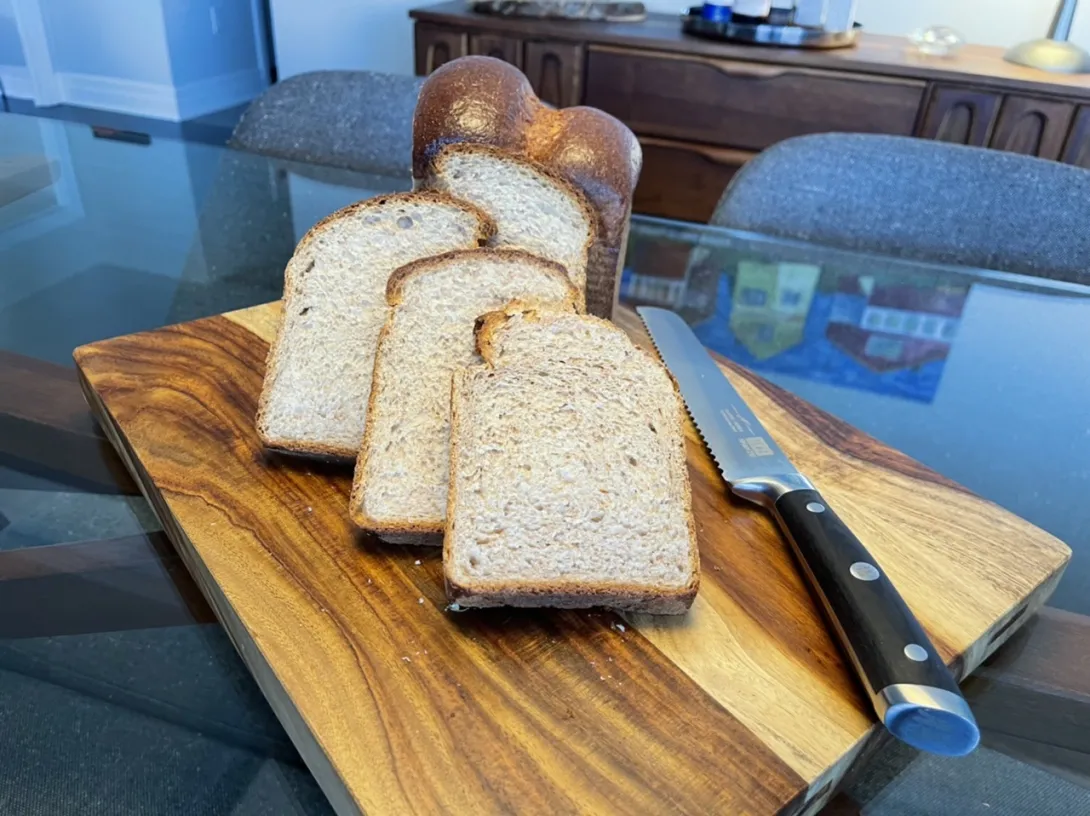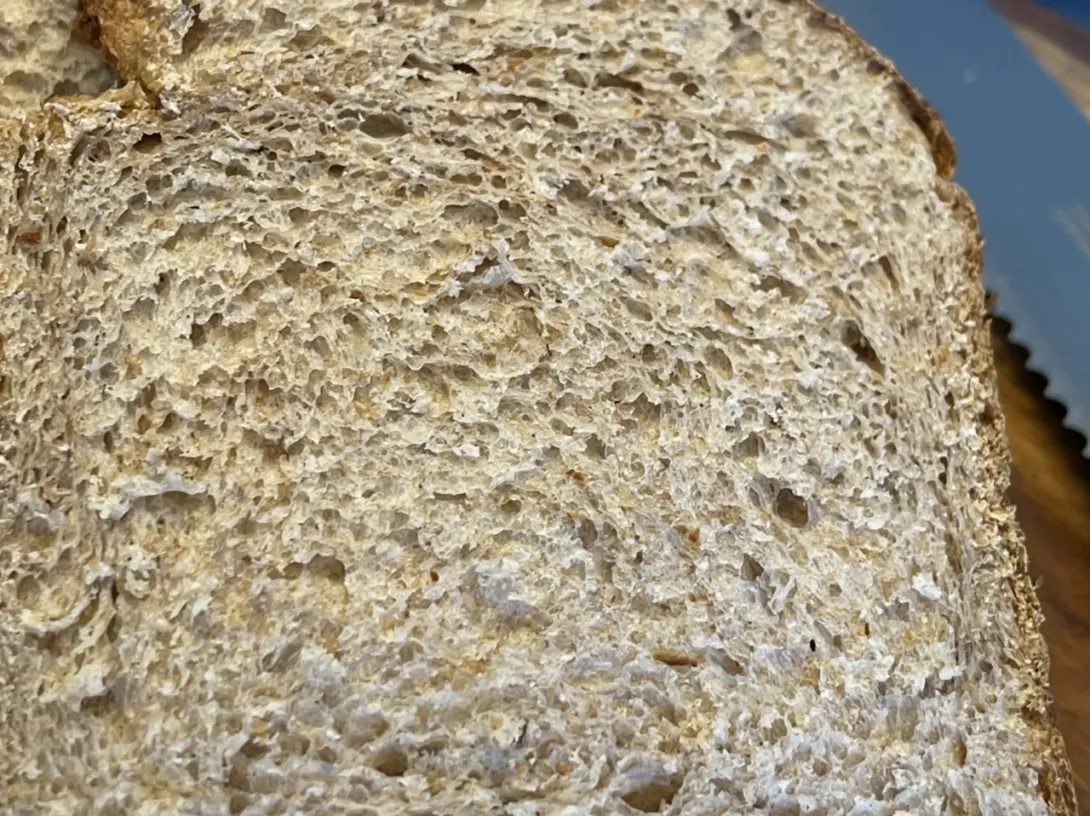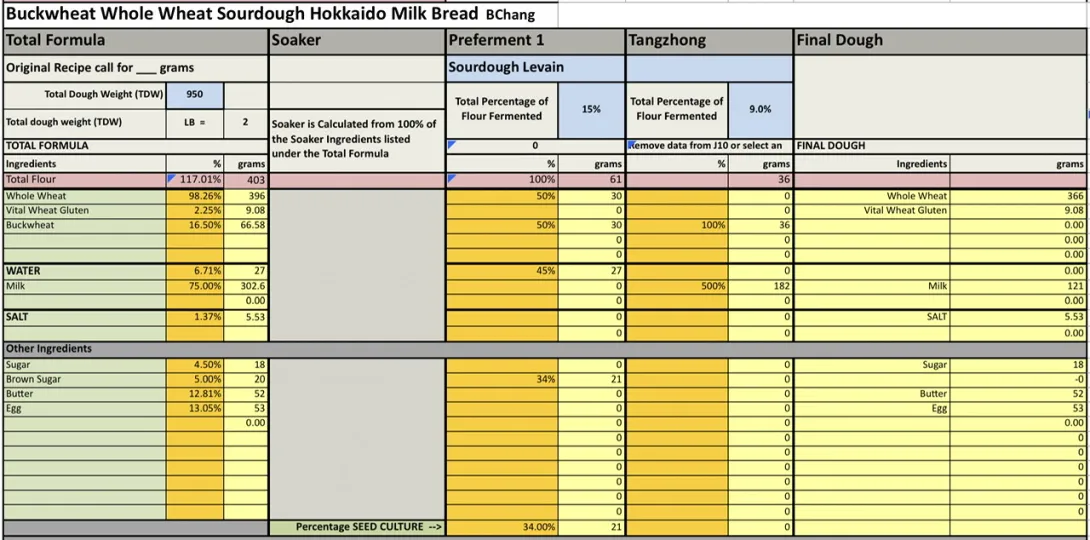I still have a bag of whole buckwheat flour from Anita’s Mill that I am finding hard to use up. I decided to try it in a milk bread for something a bit different. Then because buckwheat has no gluten I decided I’d use it in the tangzhong and also as half the flour in the levain. Buckwheat is neither a grain nor a grass, in fact it is a flowering plant related to rhubarb and sorrel. It is considered a pseudo cereal. The seeds of buckwheat are what is used to make the flour and it is becoming in vogue at the moment in French bakeries for bread.



I forgot to take photos of the loaf prior to slicing so you’ll have to settle for the sliced photos.
Instructions
Levain
Mix the levain ingredients in a jar or pyrex container with space for at least 300% growth.
Press down with your knuckles or silicone spatula to create a uniform surface and to push out air.
At a temperature of 76-78ºF, it typically takes up to 10-12 hours for this sweet stiff levain to be at peak. For my starter I typically see 3-3.5 times increase in size at peak. The levain will smell sweet with only a mild tang.
Tangzhong
In a sauce pan set on medium heat, stir the milk and flour until blended. Then cook for several minutes until well thickened, stirring regularly with a spoon or heat-resistant spatula. Let cool in the pan or, for faster results, in a new bowl. Theoretically it should reach 65ºC (149ºF) but I don’t find I need to measure the temperature as the tangzhong gelatinizes at this temperature. You can prepare this the night before and refrigerate it, ensure that it is covered to prevent it from drying out.
If you plan on using a stand mixer to mix this dough, set up a Bain Marie and use your stand mixer’s bowl to prepare the tangzhong.
Dough
In the bowl of a stand mixer, add the milk (consider holding back 10 g of milk and adding later if this is the first time you’re making this), egg, tangzhong, salt, sugar and levain. Mix and then break up the levain into many smaller pieces. Next add the flour and vital wheat gluten. I like to use my spatula to mix until there aren’t many dry areas. Allow the flour to hydrate (fermentolyse) for 20-30 minutes. Mix on low speed and then medium speed until moderate gluten development this may take 5-10 mins. You may want to scrape the sides of the bowl during the first 5 minutes of mixing. Next add room temperature butter one pat at a time. The dough may come apart, be patient, continue to mix until it comes together before adding in more butter. Once all the butter has been added and incorporated increase the speed gradually to medium. Mix at medium speed until the gluten is well developed, approximately 10 mins. You will want to check gluten development by windowpane during this time and stop mixing when you get a good windowpane. You should be able to pull a good windowpane, not quite as good as a white flour because the bran will interrupt the windowpane somewhat.
On the counter, shape the dough into a tight ball, cover in the bowl and ferment for 2 - 3 hours at 82ºF. There may be some rise visible at this stage.
You can next place the dough into the fridge to chill the dough for about 1.5 hours, this makes rolling the dough easier to shape. Remember, if you do so the final proof will take longer. Alternatively, you can do a cold retard in the fridge overnight, however, you may find that this increases the tang in your bread.
Prepare your pans by greasing them with butter or line with parchment paper.
Lightly flour the top of the dough. Scrape the dough out onto a clean counter top and divide it into four. I like to weigh them to have equal sized lobes. Shape each tightly into a boule, allow to rest 5 mins. Using a rolling pin roll each ball out and then letterfold. Turn 90* and using a rolling pin roll each out to at least 8”. Letterfold again from the sides so you have a long narrow dough. Then using a rolling pin, roll flatter but keeping the dough relatively narrow. The reason to do this extra letterfold is that the shorter fatter rolls when placed in the pan will not touch the sides of the pan. This allows the swirled ends to rise during final proof, this is only done for appearance sake and is not necessary. Next roll each into a tight roll with some tension. Arrange the rolls of dough inside your lined pan alternating the direction of the swirls. This should allow a greater rise during proof and in the oven.
Cover and let proof for 3.5-4 hours at a warm temperature. I proof at 82°F. You will need longer than 3.5-4 hours if you chilled your dough for shaping. I proof until the top of the dough comes to within 1 cm of the top edge of the pan.
Preheat the oven to 350F and brush the dough with the egg-milk wash. Just prior to baking brush with the egg-milk wash again.
Bake the loaves for 50 minutes or until the internal temperature is at least 190ºF, rotating as needed to get even browning. Shield your loaf if it gets brown early in the baking process. After 50 mins remove the bread from the pan and bake a further 10 mins by placing the loaf directly in the oven on the rack with the oven turned down to 325ºF. You can brush the top of the loaf with butter if you wish at this point while the bread is still hot to keep the top crust soft.
- Benito's Blog
- Log in or register to post comments
Looks great Benny. Is the buckwheat a flour?
Cheers,
Gavin
Sorry Gavin, I should have written buckwheat flour so yes it is the flour.
Benny
Looks excellent for this type of bread. How did it taste? I haven’t used buckwheat for a while but I remember it imparts a pleasant nutty flavor.
Happy baking.
ian
I didn’t toast the flour which would have brought forward the flavour of the buckwheat more. In this bread the buckwheat is more of a hint in the background of the flavours from the whole wheat, butter and milk.
Benny
That looks great Benny, especially for that much buckwheat. Did the buckwheat work well on the tangzhong? Anything abnormal from what you typically see?
The tangzhong seemed to take a bit longer to gelatinize. The dough was definitely weaker and more apt to tear than usual that was noticeable. I would probably make this again but toast the buckwheat flour, increase the tangzhong percent but leave the buckwheat out of the levain.
Benny
A buckwheat community bake? Lots of interesting and diverse breads with buckwheat lately. I baked this one over the weekend: http://theryebaker.com/holstein-fine-ryeholsteinisches-feinbrot-germany/
That looks like an interesting bread too.